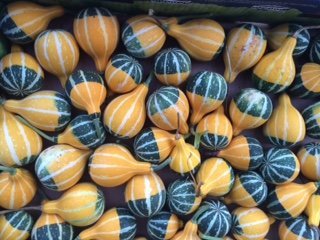Gourds

Lagenaria, Curcurbita, or Luffa spp.
Gourds are perhaps the first crop to be grown on both sides of the Atlantic ocean; originating in Africa, they most likely floated to South America and beyond, and were quickly pressed into gardener service for their many uses as storage and transportation vessels for water, food, seed, and storage.
taken from
The Georgia Fruit and Vegetable Book
by Walter Reeves and Felder Rushing
There are many kinds, from small ornamental gourds to very large birdhouse or basket gourds, and include dozens of varieties of each. Immature fruits of most are edible like summer squash.
Grow gourds exactly as you would pumpkins or cucumbers, but for well-shaped fruits, provide a trellis for the fast-growing vines to clamber over. Plant the large seed an inch deep as soon as the soil warms in spring, and leave the fruits on the vine until they turn dull and harden; you can even leave them on the vine until after frost. Cut from the vines with a small piece of stem attached, place in a well-ventilate place to dry and cure more thoroughly.
Varieties to look for include luffa (Luffa aegyptiaca), whose mature fruits are peeled and the inside “skeleton” used as a dishrag or bath time scrubber; immature luffa gourds can be eaten when young and are sometimes referred to as “running okra”). Ornamental gourds (Curcurbita pepo ovifera), have yellow flowers and produce the great majority of small ornamental gourds in many shapes and sizes, of one color or with stripes. White-flowered gourds (Lagenaria spp.) bear fruit any where from two inches to over three feet in diameter; these may be round, bottle-shaped, birdhouse, crooked neck, long neck, spoon shaped, or dumbbell shaped.












